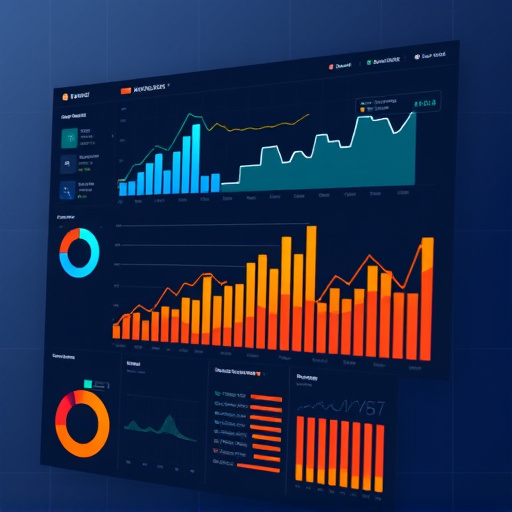Mastering Custom Layouts in Professional Website Design

Custom layouts and strategic design architecture are vital for professional website design, enhancin…….
In today’s digital age, a professional website is no longer a luxury but a necessity for businesses and organizations of all sizes. It serves as the virtual face of a company, offering a platform to connect with customers, showcase products or services, and establish credibility in the market. Professional website design is the art and science of creating such websites that not only captivate users but also drive conversions and foster business growth. This article aims to provide an extensive exploration of this dynamic field, covering its fundamentals, global impact, economic implications, technological innovations, regulatory landscape, challenges, case studies, and future prospects. By delving into these aspects, we will equip readers with a comprehensive understanding of professional website design and its pivotal role in shaping the digital world.
Professional website design encompasses the entire process of developing and maintaining websites that are aesthetically pleasing, user-friendly, and aligned with business objectives. It involves a multidisciplinary approach combining graphic design, web development, content creation, and marketing strategies. The core components include:
Visual Design: This involves creating an attractive and consistent visual identity, including color schemes, typography, imagery, and layout, to ensure the website aligns with the brand’s image.
User Experience (UX) Design: UX design focuses on making websites intuitive and easy to navigate, ensuring users can find information or services efficiently. It involves wireframing, prototyping, and user testing.
Web Development: Developers transform the design concepts into functional websites using coding languages like HTML, CSS, JavaScript, and server-side languages (e.g., Python, PHP). They also integrate content management systems (CMS) for easy content updates.
Content Creation: High-quality, optimized content is essential for engaging users and improving search engine rankings. This includes text, images, videos, and interactive elements tailored to the target audience.
Accessibility and Responsive Design: Websites should be accessible to all users, including those with disabilities. Responsive design ensures the website adapts seamlessly to various devices and screen sizes.
The concept of professional website design has evolved significantly since the early days of the internet. In the 1990s, websites were primarily text-heavy, often lacking visual appeal and interactivity. As web technologies advanced, designers started incorporating multimedia elements, dynamic content, and more sophisticated layouts. The turn of the millennium saw a surge in the popularity of flash animation, which added richness to website design but also slowed down loading times.
The mid-2000s marked a shift towards simplicity and usability, with an emphasis on clean navigation and clear call-to-actions. This era also witnessed the rise of content management systems, making it easier for non-technical users to manage their websites. Today, professional website design places a strong emphasis on mobile responsiveness, fast loading times, search engine optimization (SEO), and creating seamless user experiences across devices.
Professional website design has left an indelible mark on businesses worldwide, with regions adopting unique approaches and trends:
North America: Known for its cutting-edge technology and innovation, North American websites often feature advanced interactive elements, multimedia content, and data visualization. The focus is on providing a seamless user experience across multiple devices.
Europe: European designs tend to prioritize simplicity, accessibility, and compliance with strict privacy regulations (e.g., GDPR). Minimalist aesthetics and clear, concise content are common.
Asia Pacific: Websites in this region often incorporate unique cultural elements and vibrant visuals. Mobile optimization is crucial due to the high penetration of smartphones. E-commerce websites are also prominent, featuring user-friendly payment gateways and secure transactions.
Latin America: Here, designers often work with limited resources, focusing on cost-effective solutions while still delivering visually appealing and functional websites. Personalization and localization are key to connecting with diverse local markets.
Mobile First Approach: With mobile internet usage surpassing desktop, a majority of new websites are designed with a mobile-first strategy, ensuring optimal performance on smaller screens first.
Voice Search Optimization: As voice assistants gain popularity, designers are incorporating conversational language and optimizing content for voice search queries.
Personalization: Websites increasingly use data analytics to offer personalized experiences, tailored recommendations, and targeted marketing campaigns.
Progressive Web Apps (PWAs): PWAs combine web and app-like features, providing users with an offline experience and faster loading times, leading to higher engagement.
Augmented Reality (AR) and Virtual Reality (VR): AR and VR technologies are being integrated into website design to create immersive experiences, especially in retail, real estate, and entertainment sectors.
Professional website design is a significant component of the global digital economy, with a substantial market size and growing demand. According to a report by Grand View Research, the global web design market size was valued at USD 184.7 billion in 2020 and is expected to grow at a CAGR of 12.3% from 2021 to 2028. This growth is driven by increasing internet penetration, rising e-commerce sales, and the need for businesses to establish an online presence.
Companies across industries are investing heavily in professional website design:
Small Businesses: Many small enterprises are turning to affordable web design solutions and DIY platforms to create basic websites, enabling them to compete in the digital space.
Medium to Large Enterprises: These organizations often hire specialized web design agencies or in-house teams for custom designs that align with their brand identity and business goals. They invest in advanced features, e-commerce functionality, and ongoing maintenance.
E-commerce Giants: Amazon, Alibaba, and other online retail giants continuously refine their website design to enhance user experiences, improve conversion rates, and drive sales.
Professional website design has a ripple effect on the economy:
Job Creation: It supports numerous jobs, including web designers, developers, content writers, UX researchers, and project managers.
Business Growth: Well-designed websites contribute to increased online sales, improved customer retention, and expanded market reach, ultimately boosting revenue and economic growth.
Digital Transformation: Businesses that invest in professional website design often undergo digital transformation, adopting new technologies and processes to stay competitive in the digital age.
Artificial Intelligence (AI) and Machine Learning (ML): AI/ML algorithms power personalized content recommendations, chatbots, and image recognition features, enhancing user engagement and experience.
Blockchain: This technology is being explored for secure online transactions, content verification, and decentralized data storage, offering new possibilities for website functionality and security.
Cloud Computing: Cloud-based web hosting provides scalability, flexibility, and cost savings. It enables designers to create websites that can handle high traffic and dynamic content.
The future of professional website design is poised for significant advancements:
Adaptive Design: Websites will become even more responsive, adapting seamlessly to any device or screen size, providing an optimal experience regardless of the user’s platform.
Augmented Reality (AR) Integration: AR technology will enable interactive and immersive experiences on websites, especially in retail and real estate, allowing users to visualize products or properties virtually.
Voice User Interfaces (VUIs): As voice assistants become more prevalent, VUIs will make web interactions hands-free, opening up new possibilities for content delivery and user engagement.
Decentralized Web (Web3): The rise of blockchain technology may lead to a decentralized web, where users have more control over their data and online identities, potentially reshaping website design and functionality.
Professional website design is subject to various policies and regulations that vary by region:
Data Privacy Laws: Regulations like GDPR in Europe, CCPA in California, and similar data protection acts worldwide mandate how businesses must handle user data, including obtaining consent for data collection and ensuring data security.
Copyright and Intellectual Property: Website designers must adhere to copyright laws and respect intellectual property rights when using images, content, or code from third-party sources.
Industry-Specific Regulations: Certain industries, such as healthcare (HIPAA) and finance (GDPR, PCI DSS), have specific regulations regarding data security, privacy, and website content.
These policies and regulations significantly influence the design and development processes:
Consent and Transparency: Websites must obtain user consent for data processing and provide clear privacy policies, ensuring transparency in data handling practices.
Data Security Measures: Designers implement robust security protocols to protect user data, including encryption, secure hosting, and regular security audits.
Accessibility Standards: Many countries have accessibility guidelines (e.g., WCAG) that web designers must follow to ensure websites are usable by people with disabilities.
Professional website design faces several challenges:
Keeping Up with Technology: The rapid pace of technological change requires designers to continuously update their skills, which can be demanding and expensive.
Mobile Optimization: Ensuring websites are optimized for various mobile devices and screen sizes remains a challenge, especially with the ever-growing diversity of devices.
SEO Complexity: Search engine optimization has become increasingly complex, requiring designers and developers to implement best practices from the outset to achieve high rankings.
Accessibility Compliance: Making websites accessible to all users, including those with disabilities, can be technically challenging and often requires specialized knowledge and tools.
Continuous Learning and Collaboration: Designers should embrace lifelong learning, stay updated with industry trends, and collaborate with developers and UX specialists to address technical challenges.
Mobile-First Approach: Adopting a mobile-first design philosophy from the beginning can significantly reduce optimization issues across devices.
SEO Integration: Incorporating SEO best practices during the design and development phases ensures better search engine rankings and reduces the need for costly post-launch optimizations.
Accessibility Tools and Guidelines: Utilizing accessibility evaluation tools and adhering to WCAG guidelines can make websites more inclusive without compromising aesthetics or functionality.
Airbnb transformed its website design by focusing on a seamless user experience and personalized recommendations. They utilized machine learning algorithms to analyze user behavior and preferences, offering tailored property suggestions. The updated design improved conversion rates, with users spending more time exploring listings and booking experiences. This case demonstrates the power of combining advanced technologies with user-centric design principles.
Netflix’s website design is a testament to the effectiveness of interactive elements in engaging users. Their homepage features personalized content recommendations, allowing users to discover new shows and movies effortlessly. The use of high-quality visuals, interactive trailers, and user-friendly navigation has contributed to Netflix’s global success, setting a benchmark for streaming platform design.
The UK government’s gov.uk website is celebrated for its exceptional accessibility and simplicity. Designed with a focus on inclusivity, it adheres to strict WCAG guidelines, ensuring all users can access information easily. The clean, uncluttered design enhances usability, making complex government services more accessible to citizens. This case study highlights the importance of combining accessibility standards with minimalist aesthetics.
Voice User Interfaces (VUIs): As voice assistants become more prevalent, VUIs will enable hands-free interactions, making web content more accessible.
Immersive Web: The rise of AR and VR technologies will create immersive online experiences, transforming e-commerce, travel, and entertainment websites.
Progressive Web Apps (PWAs): PWAs will continue to gain popularity due to their ability to provide app-like experiences without the need for separate app downloads.
Personalization at Scale: Businesses will leverage data analytics and AI to offer personalized experiences to a larger audience, increasing engagement and conversion rates.
Sustainability Focus: Website design will incorporate eco-friendly practices, such as energy-efficient hosting, paperless communication, and sustainable branding elements.
Privacy and Security Enhancements: With evolving privacy regulations, websites will continue to invest in robust security measures and transparent data handling practices to gain user trust.
Professional website design is a dynamic field that continues to evolve with technological advancements and changing user expectations. From its early days as a simple online brochure to today’s complex digital experiences, it has played a pivotal role in shaping businesses and their interactions with customers. As we look ahead, the focus will remain on creating accessible, engaging, and secure websites that deliver exceptional user experiences.
The global impact of professional website design is evident, with regions adopting unique trends and innovations while facing common challenges related to technology, accessibility, and regulatory compliance. By embracing new technologies, staying informed about industry best practices, and prioritizing user needs, designers can contribute to the digital transformation of businesses worldwide. As the digital landscape continues to evolve, professional website design will remain a cornerstone of successful online presence and business growth.
Q: How important is mobile optimization for modern websites?
A: Mobile optimization is crucial due to the widespread use of smartphones and tablets. Websites that are not optimized for mobile devices often face higher bounce rates, lower engagement, and reduced search engine rankings. A mobile-first design approach ensures a seamless experience across all platforms.
Q: What role does SEO play in website design?
A: SEO (Search Engine Optimization) is essential for making websites visible to potential customers. Designers should implement best practices during development, including optimizing content, improving site speed, and ensuring proper header structure, to achieve better search rankings and drive organic traffic.
Q: How can I make my website more accessible?
A: Making a website accessible involves following accessibility guidelines (e.g., WCAG) and utilizing specialized tools. This includes providing text alternatives for images, ensuring proper color contrast, using clear language, and implementing keyboard navigation. Regular testing and user feedback are also vital to improving accessibility.
Q: What are some emerging technologies in web design?
A: Emerging technologies include Voice User Interfaces (VUIs), Augmented Reality (AR), Virtual Reality (VR), and Progressive Web Apps (PWAs). These innovations offer new ways to enhance user engagement, create immersive experiences, and provide app-like functionalities without separate app downloads.

Custom layouts and strategic design architecture are vital for professional website design, enhancin…….

Integrating Content Management Systems (CMS) into professional website design is crucial for South F…….

Creating effective professional website designs requires understanding user behavior through data an…….

A professional website design is essential for local businesses to boost online credibility, SEO ran…….

A professionally designed website boosts online marketing for local businesses by enhancing brand pe…….

Businesses can achieve high-quality, affordable professional website design by embracing current tre…….

Measuring professional website design success through key metrics like traffic growth, conversion ra…….

Minimalist professional website design in Frisco enhances user experiences with simplicity, clean li…….

A professional website design focused on user experience and high-quality visuals is crucial for Sou…….